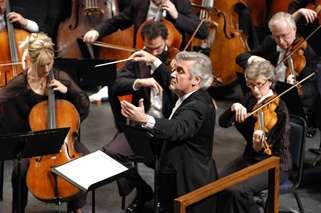|
Back
Taking stock, rich and warm Ottawa
Southam Hall, National Arts Centre
06/03/2015 - & June 4, 2015
Felix Mendelssohn: Violin Concerto No. 2 in E minor, Op. 64
Gustav Mahler: Symphony No. 1 in D major
Gil Shaham (violin)
National Arts Centre Orchestra, Pinchas Zukerman (conductor)

P. Zukerman (© Fred Cattroll)
Pinchas Zukerman returns to the podium this week for the first of his three final pairs of performances, completing his sixteenth and final season as music director of Ottawa’s National Arts Centre Orchestra (NACO). It’s been a long, productive tenure, and there is no question Zukerman has achieved much and has left his mark on the ensemble, and done so via much more than already being an international celebrity when he began the job in 1999, thirty years after the orchestra’s founding.
The NACO initially had been a chamber size orchestra. In the late 1960s, governments and other benefactors considered that with large, established symphony orchestras in nearby Montreal and Toronto, yet another such ensemble could be fiscally inadvisable, a view reinforced by the collapse a few years earlier of the old semi-professional (and quite good) Ottawa Philharmonic Orchestra. Also, since the National Arts Centre was designed as a multi-theatre facility to showcase Canadian and visiting performing artists including opera and dance, the view was that a chamber size orchestra could moonlight as pit orchestra for visiting companies such as The National Ballet of Canada and The Canadian Opera Company, both Toronto based.
The formula was an immediate success and NACO’s founding conductor, the late Mario Bernardi (already a respected opera maestro in London and New York) proved an inspired choice. His successors, Franco Mannino, Gabriel Chmura and Trevor Pinnock, continued this tradition as the decades unfolded.
When Zukerman took the reins, things did begin to change. He and the National Arts Centre’s administration and board agreed it was time to expand, and the orchestra now is larger, if not quite the size of the biggest symphonies. And Zukerman has taken the opportunity to develop a larger sound, specifically the kind of warm, hefty sonority associated with major, more established German orchestras. (However, I can clarify that in past concerts, including the 2014-15 season, Zukerman has often used scaled down forces and clearly respects the chamber orchestra origins which his players, a few, still from the first 1969-70 season, love and manage with alacrity.)
This week’s program was an excellent illustration of this and, while not an evening which accomplished everything being attempted, it was a grand event and the two major works performed both received ecstatic ovations.
Mendelssohn’s exquisite Violin Concerto in E minor is a work that might have been commissioned for NACO. From the first notes Zukerman drew sounds that were rich and warm, especially the strings. The soloist, Gil Shaham, is an American violinist celebrated for his immaculate tone and technique, which were consistent throughout the performance, particularly during the delicately elaborate first movement cadenza. If there was a problem, Shaham didn’t seem to project sufficiently over the orchestra. Nonetheless, this was playing which likely inspired listeners to hear him again at the next opportunity.
After intermission Mahler’s Symphony No. 1, “The Titan” was the evening’s major work. Zukerman led a reading which was often brilliant and technically accomplished, and was characterized by the warm acoustic many would associate with The Vienna Philharmonic or, closer to home, The Montreal Symphony during its heyday under Charles Dutoit (in fact, Montreal and Dutoit gave a brilliant performance of Mahler’s Symphony No. 9 in Ottawa some thirty years ago).
Even with the sonic warmth, phrasing overall could have been more sensuous, and even a bit more rubato would have been welcome, especially in the third movement with Mahler’s typically affectionate use of folk elements (everything from Frère Jacques to Gypsy tunes). Not surprisingly, it was the string players who fared best under Zukerman’s baton; their work was consistently subtle and tightly controlled through a huge dynamic range. Among brass and woodwinds, there was some fine first desk work though throughout the Symphony these players tended to be a bit too loud, especially at the beginning, which needs to be really hushed.
The Mahler didn’t really come together until the brief fugue toward the tumultuous close of the final movement, but was worth the wait. While June brings Zukerman’s NACO tenure to a completion, he’ll be returning as a guest conductor and we can expect more, and more rarified Mahler, I’d wager.
Charles Pope Jr.
|